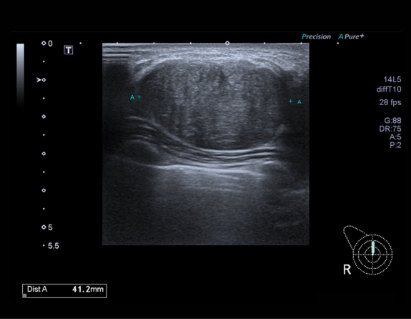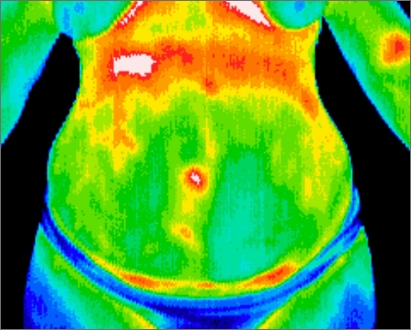Every screening has its strengths and limitations. Since no breast test is 100% accurate 100% of the time, a multimodal approach, using thermography and ultrasound together, undoubtedly increases your chances of detection.
Services
Consider a Multimodal Approach
• No Pain
• No Radiation
• No Doctor Referral Needed
We’ll make it easy for you to prioritize your health.

Increase your chances of detection.
No screening is 100% accurate, but each has its own strengths. That’s why it’s important to consider a multimodal approach by incorporating thermography and ultrasound into your regular health regimen. By using tests that review multiple aspects of the body, the chances of detecting abnormalities increase exponentially.

Get a comprehensive view of your health.
Thermography examines the functional activity in your body, while ultrasound looks at your body from a structural perspective. By monitoring both, you’ll get a comprehensive view of how your body is working and if any abnormalities are present.

Save time and money.
Take advantage of the time and savings by booking a combination appointment at one facility.
Here’s what to expect with a multimodal approach.
Increasing chances of detection with multimodal combinations.
Breasts & Underarms
Increase your chances of detection by utilizing both thermography and ultrasound breast screenings. Breast thermography monitors the functional activity such as inflammation and abnormal thermal patterns, while a breast ultrasound examines structural components of the breast tissue.
Breast thermography’s ability to detect a precancerous state or signs of cancer in the breast at an early stage lies in its unique capability of monitoring the temperature variations and blood vessel alterations produced by the earliest changes in tissue physiology often before a lump even presents itself and is detectable by other structural tests.
Breast ultrasound identifies suspicious masses in the breast tissue and lymph glands to determine whether a lump is a fluid-filled cyst or a solid mass. It can also detect issues related to lumps, unusual nipple discharge, mastitis, breast pain, redness, and swelling.
Both thermography and ultrasound are highly beneficial for women with dense breast tissue. Because dense tissue and cancer both appear white on a mammogram image, the sensitivity and detection rates can be greatly reduced. It is estimated that approximately 50% of women have dense breasts and studies have shown that ultrasound significantly increases detection from 48% to 97% than mammograms alone. Using both tests to monitor the functional and structural aspects of the breast will undoubtedly increase your chances of early detection.
This may be valuable for:
• Dense breasts
• Implants
• Breast pain
• Proactive approach




Women’s Health Check
The Women’s Health Check (WHC) is a comprehensive combination screening focusing specifically on women’s health concerns and needs by utilizing both thermography and ultrasound. Thermography is monitoring the functional activity of your body looking for abnormal thermal patterns and inflammation while ultrasound is examining the structures of your body to look for masses, cysts, and organ size. Each test provides different yet complementary information as part of a multimodal screening program.
By providing thermal findings related to breast, OB-GYN, thyroid, endocrine, visceral, and autonomic (nerve) status, it provides a holistic view of your overall health and future risk levels. The easy-to-understand report specifically identifies findings related to estrogen dominance, symptoms of adrenal fatigue or insufficiency, thyroid dysfunction, and hormone imbalance.
The ultrasound will provide structural findings that include breasts and pelvic organs and you can choose between the right upper abdomen (liver, pancreas, gallbladder, and right kidney) or thyroid.
Both screenings will help support your wellness planning and can be used as part of a preventative health program giving you and your practitioner signs of abnormalities before they become serious health issues. They will assist you in taking positive action to improve your health whether through lifestyle changes, holistic treatments, or medical intervention. An annual WHC is ideal for monitoring changes year to year to show your progress or potential new concerns.
Thermography Women’s Health Check includes breasts, abdomen, head & neck, carotid arteries & thyroid.
Ultrasound Women’s Health Check includes breasts and pelvic organs, then choose between right upper abdomen or thyroid.
This may be valuable for:
• Breast health
• Organ dysfunction
• Thyroid issues
• Hormone imbalances














Full Body
Full body thermography is a comprehensive head-to-toe view of the entire body (and includes the breasts for female clients) which will provide you with abundant information. Thermography has many applications for full-body imaging such as detecting and monitoring a number of diseases, physical injuries, and overall inflammation in the body.
Thermography can help you visualize pain when other tests fail to find the cause. Full-body imaging may provide you with new health information and/or help monitor illnesses you may be dealing with. It’s an excellent first screening step that may help you decide if further investigation or treatments may be warranted. Not only are we looking for areas of concern but the screening can also help confirm your healthy lifestyle habits are benefiting you.
Breast ultrasound identifies suspicious masses in the breast tissue and lymph glands to determine whether a lump is a fluid-filled cyst or a solid mass. It can also detect issues related to lumps, unusual nipple discharge, mastitis, breast pain, redness, and swelling.
This may be valuable for:
• Comprehensive head-to-toe imaging
• Monitoring whole body health
• Proactive approach
• Inflammation
• Breast health
Full Body Resources:






Abdomen | Pelvic
Abdominal thermography can assist in detecting and monitoring a variety of issues involving our vital organs and systems such as inflammation or dysfunction with the kidneys, liver, colon, digestive system, major muscle groups, spine and discs, urinary system, and female reproductive organs. Often, we are able to pinpoint the origin of pain patterns that frequently stem from nerve impingement, trigger points in the muscles, or myofascial dysfunction. All of this information is valuable in helping you decide how to move forward in treating various conditions.
An abdominal ultrasound allows for visualization of the organs and structures. It can help your practitioner evaluate the cause of stomach pain or bloating and help check for kidney stones, liver disease, tumors, and many other conditions. It can also give you peace of mind that your organs are in normal condition and functioning properly. The complete abdominal screening examines the liver, pancreas, gallbladder, spleen, right and left kidney, while the right upper abdominal screening examines the liver, pancreas, gallbladder, and right kidney.
If female organs are more of your concern then you can choose a pelvic ultrasound that includes transabdominal views of the female organs including the uterus, endometrium, cervix, vagina, ovaries (if not obscured by bowel), adnexas, and fallopian tubes. It is used to detect and/or monitor endometrial thickening, uterine fibroids or scars, ovarian cysts and masses, and tumors. If additional views are needed then a transvaginal exam may be performed.









What happens next.
Explore multimodal pricing and packages.
Breast Thermography & Ultrasound Combo
$499
(60-80 minutes)
Includes your initial breast thermography & ultrasound appointment.
Thermography Women’s Health Check & Breast Ultrasound
$649
(80 minutes)
Includes thermography of both breasts, abdomen, thyroid, carotids, head & neck and bilateral breast ultrasound.
Full Body Thermography & Breast Ultrasound
$739
(1 hr 40 minutes)
Includes a full body thermography and bilateral breast ultrasound.
Thermography & Ultrasound Women’s Health Check
$1069
(2 hours 40 minutes)
Includes both women’s health check screenings. Thermography includes both breasts, abdomen, thyroid, carotids, head & neck. Ultrasound includes breasts and pelvic organs, then choose between right upper abdomen or thyroid.
Breasts &
Underarms
$249
(20-40 minutes)
Includes both breasts, underarm lymphatic region, and upper back.
Breast
Baseline Package
$468
(20-40 minutes)
Includes your initial and 3-month follow up thermography appointments.
Women’s
Health Check
$399
(40 minutes)
Includes both breasts, abdomen, thyroid, carotids, head & neck.
Breasts & Abdomen
(or Any 2 Regions)
$329
(20-40 minutes)
Choose two regions: breasts, head & neck, abdomen, immune health check, arms, or legs.
Half
Body
$399
(40 minutes)
Includes everything but the legs and feet.
Full
Body
$489
(60 minutes)
Includes the entire body including the breast region for female clients.
Breasts & Underarms
$295
(40 minutes)
Examines both breasts and underarm lymphatic glands. Also used to determine if any lumps are solid masses or fluid-filled cysts.
Women’s Health Check
$725
(80 minutes)
Includes breasts and pelvic organs, then choose between right upper abdomen or thyroid.
Complete Abdomen
$265
(40 minutes)
Includes liver, pancreas, gallbladder, spleen, right and left kidney.
Thyroid
$220
(30 minutes)
Examines the thyroid to assess size, lumps, nodules, or masses.
Breasts & Complete Abdomen
$525
(80 minutes)
Includes both breasts, lymph nodes, liver, pancreas, gallbladder, spleen, right and left kidney.
Pelvic
$255
(40 minutes)
Includes abdominal views of all female reproductive organs. Trans-vaginal exam may be performed only if needed.
Frequently Asked Questions
Why should I get a thermography scan and an ultrasound?
We can all agree that early detection saves lives. By implementing more than one screening to your regular routine you’ll be able to increase your chance of detection. Thermography monitors the functional activity of your breast tissue – looking for abnormal changes or signs of pathology at a very early stage. Ultrasound is a structural test – meaning it can look at lumps, masses, and cysts and determine if they are solid or fluid-filled. Every screening has its strengths and limitations. Since no breast test is 100% accurate 100% of the time, a multimodal approach (thermography and ultrasound together) undoubtedly increases your chances of detection. By utilizing both screenings you will receive a more comprehensive view of an area of concern and your overall health. Clinical trials demonstrated that thermography significantly augments the long-term survival rates of its recipients by as much as 61%. When used as part of a multimodal approach (ultrasounds, clinical examination, mammography, and infrared imaging), 95% of all early-stage cancers will be detected. By taking advantage of additional screening methods clients and their doctors are then able to identify early signs of pathology and gain valuable time to take proactive approaches earlier on.
Do both scans happen in the same appointment?
Yes, absolutely. We currently have 6 metro Atlanta locations that can accommodate both scans in one appointment should you choose to do so. Visit our pricing page to view combo appointment pricing.
What’s the difference between thermography and ultrasound?
While both screenings are non-invasive, pain and radiation free they are two completely different technologies. Thermography uses an infrared camera to detect thermal heat patterns that may indicate abnormal activity and inflammation inside the body. This can help detect disease processes even before symptoms arise. Ultrasounds, while also noninvasive, use high-frequency sound waves to create images or videos of organs, vessels, and other structures inside the body. It can determine if a lump is a fluid-filled cyst or a solid mass and can also take specific measurements to monitor changes.
Which test is best for me?
Both screenings have their strengths and their limitations so it depends on what your concern or goal is. For example, if you have a palpable lump then an ultrasound would be recommended to more precisely identify and measure the lump now that it is an existing structure. However, if your concern is inflammation or unexplained pain then thermography will provide more helpful information. Of course, by implementing both screenings to your routine breast health regimen you will increase your chances of detection but ultimately is a personal decision.
When should I consider getting both scans?
According to the CDC, women 40 to 44 years old should consider breast cancer screenings once a year. However, if you have a family history of breast cancer or other types of cancer, it’s advisable to start even earlier.
It is never too early to gain peace of mind by implementing a multimodal screening approach.

